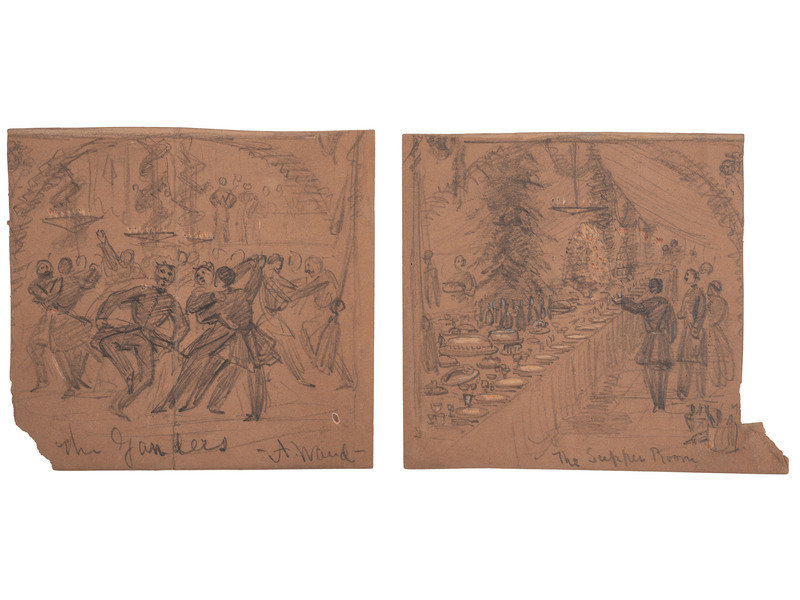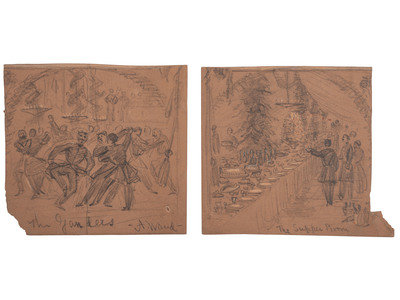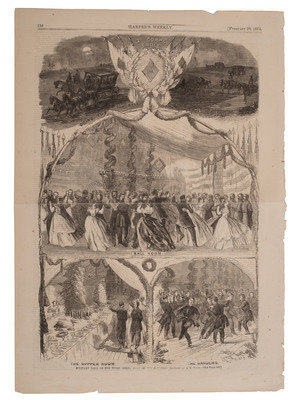Condition Report
Contact Information
Auction Specialist
Lot 153
[CIVIL WAR]. WAUD, Alfred R. (1828-1891), artist. A group of 2 Civil War-period sketches of the Military Ball of the Third Corps, Army of the Potomac, February 1864.
Sale 1250 - American Historical Ephemera & Photography
Nov 30, 2023
10:00AM ET
Live / Cincinnati
Own a similar item?
Estimate
$1,000 -
1,500
Price Realized
$630
Sold prices are inclusive of Buyer’s Premium
Lot Description
[CIVIL WAR]. WAUD, Alfred R. (1828-1891), artist. A group of 2 Civil War-period sketches of the Military Ball of the Third Corps, Army of the Potomac, February 1864.
2 sketches, both pencil on brown paper, 4 1/2 x 4 1/2 in., each titled and initialed in pencil "ARW." Titles include "The Supper Room" and "The Ganders." Both original, Civil War-period sketches by Waud that were published with other sketches of the same event in Harper's Weekly, 20 February 1864. (Sketches somewhat rough, with some wear, including uneven border along right edge of "The Supper Room," and loss in lower left corner of "The Ganders.") The rough sketches are accompanied by the original page from the Harper's Weekly featuring the published sketches. Provenance: David L. Hack Civil War Art Collection (sold Cowan's, 17 November 2017, lot 115).
Noted battlefield artist Alfred R. Waud (1828-1891) was born and raised in London. He studied at the Government School of Design at Somerset House before immigrating to the United States in 1850. Upon his arrival, Waud worked primarily as a freelance artist until May of 1861 when he was retained as a sketch artist and special correspondent by the New York Illustrated Newspaper to report on the war. At the close of 1861, Waud joined Harper's Weekly, where he was employed through the end of the war. He continued to work for Harper's Weekly in addition to a number of other publishers following the war and his career flourished. While touring battlefields in the South in 1891, Waud died in Marietta, GA. The Library of Congress houses most of his original wartime sketches, with some remaining in private hands.
While the photographic process evolved rapidly from its inception in 1839 and the wet plate process of taking photographs was coming into widespread use by the start of the Civil War, it was a cumbersome process in the field as well as in the studio. More significantly, at that time, the photographs themselves could not be reproduced as illustrations accompanying written reports of the war. As a result, publishers of newspapers and other periodicals in major cities, primarily in the North, employed a number of sketch artists who traveled with armies to draw the scenes that they witnessed. These sketches, most frequently pencil on paper with brief identifications of people and places, were then sent back by courier to the periodical publishers. The battlefield sketches received by the publishers were then copied by engraving artists onto wooden blocks, which were used in printing presses to illustrate printed articles covering the war.
Unlike the photographers of the day, who were limited to capturing the aftermath of battles, the sketch artists had the advantage of recording what they were witnessing as the events occurred before their eyes.
In the 1880s, the popular Century Magazine started publishing the narratives of Civil War veterans and retained a large number of sketch artists to illustrate the articles. They used interviews, photographs, and prior war-date sketches to produce accurate pictorial representations of the war. These illustrated accounts were incorporated into a large four-volume work entitled Battles and Leaders of the Civil War in 1881. Almost a century later, in 1973, American Heritage Magazine acquired the collection of drawings that had been held by Century Magazine, which were subsequently reproduced in The American Heritage Century Collection of Civil War Art published in 1974. Christie's conducted two public auctions in 1988, which were comprised of the remaining original Century Magazine Collection of Civil War artwork that was dispersed by American Heritage Magazine, and a number of drawings by noted battlefield artists were previously acquired, including the examples offered today.



